Shortcuts:.
Environmental Issues | Being Green | Reducing Waste
Sometimes we get so lost in the excitement of developing and using new technologies that we don't thoroughly examine their effect on the world around us.
How Technology can Harm the Environment
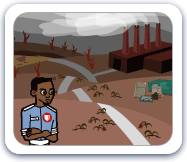
Many of the technologies we use every day consume a lot more resources and power than they need to, and using and manufacturing them can create a mess. Here are a few of the ways that technology can harm the environment:
- Pollution - Air, water, heat and noise pollution can all be caused by producing and using technology
- Consuming resources - Non-renewable resources, including precious metals like gold, are used to make technology. Many others, such as coal, are consumed to generate the electricity to use technology. Even some renewable resources, like trees and water, are becoming contaminated or are used up faster than they can renew themselves because of technology.
- Waste - Manufacturing technology creates large amounts of waste, and used computers and electronics get thrown out when they break or become outdated. Called "technotrash," these electronics contain all sorts of hazardous materials that are very unsafe for the environment. They need to be disposed of using special methods.
- Disrupting ecology - Clearing land where animals used to live to build factories and allowing pollution to contaminate the food chain can greatly affect the environment's natural cycles.
- Health hazards - Using toxic materials that can harm our health can cause cancer, and technology addiction can lead to other health problems like obesity and carpal tunnel syndrome.
You can encourage manufacturers by choosing to buy more energy-efficient and less hazardous electronics and by supporting companies that make protecting the environment a priority. You can also do your own part to reduce environmental impact by not being wasteful and disposing of your electronics safely and properly.
Carbon Emissions
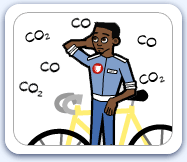
Carbon emissions, mostly carbon dioxide and carbon monoxide, are greenhouse gasses that are produced by people. Greenhouse gasses are gasses in the atmosphere that trap and reflect heat and radiation back to the planet's surface. It is believed that over the last century, the amount of greenhouse gasses in the atmosphere has increased due to carbon emissions, and that they are contributing to global warming.
Carbon emissions get released into the atmosphere from things like cars, air planes, power plants and factories. They also get released by people like you, when you use a vehicle or electricity created from burning fossil fuels. The computer you're using to read this is using electricity, and so is your mobile device and video game system. We're all guilty of enjoying things that aren't exactly eco-friendly, but if we're smarter about how we use technology, we can reduce our environmental impact.
Toxic Technotrash
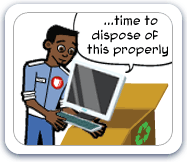
Technotrash, also called electronic waste or
e-waste, is any broken or unwanted electrical or electronic device, and is currently the most rapidly-growing type of waste.
If you just throw away technotrash with the regular trash, it usually ends up in a landfill. Most electronics contain non-biodegradable materials, and heavy metals and toxic materials like cadmium, lead and mercury. Over time, these toxic materials can leak into the ground, where they can contaminate the water we drink, the plants we eat and the animals that live around the area. Many European countries have even banned technotrash from landfills.
These toxic materials can cause all kinds of bad effects including nausea, diarrhea, vomiting and even cancer. If you keep eating and drinking contaminated food and water, these toxins can build up in your body. If you eat animals that have been contaminated, you're getting a double dose of toxins. What's even worse, your body can't properly process some of these metals and so they might take years to get out of your system.
To help protect the environment, don't put technotrash in with the rest of your household's garbage. Check with your local recycling centers to see if they take technotrash, or enter the type of trash and your zip code at Earth911.org to look for other recycling places nearby. You can also ship it to a company that specializes in disposing of technotrash, like GreenDisk.
Tips for Recycling Technotrash
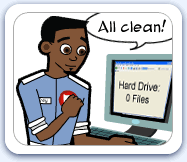
Before you recycle your technotrash, check out these tips:
Sanitize your Hard Drive
Before donating a machine, be sure to remove all of your files and data from it. Most people will just try to drag everything to the trash can or recycle bin, but this only partially erases the information! Cyber criminals can find this “deleted” information and use it however they want. To really protect yourself, you need to run a program that “sanitizes” your hard drive. These programs, which can be found online, work by replacing all your data with a jumble of useless nonsense. That way, your information is safe, and your good deed goes unpunished!
Consider Donating your Mobile Device
There are actually a LOT of great things your old mobile devices can do for people. Whether that means helping soldiers overseas talk to their families or helping victims of domestic violence, they can be a lot more than clutter for your junk drawer. Here is a list of several worthwhile charities.
Raise Some Funds
Because electronics contain precious metals including gold, silver and copper, technotrash can actually be worth a little money. Why not hold a community fundraiser to collect and dispose of everyone's technotrash? You'll be helping both your community and the environment at the same time!
Reuse Those Ink Cartridges
Many locations that sell new printer ink cartridges will refill your old cartridge for a fraction of the cost. Each cartridge you throw away takes anywhere between 400 and 1,000 years to decompose, and on average, there are 11 cartridges thrown out every minute across the globe! Not all cartridges can be refilled, and even cartridges that you've filled in the past will eventually break down after continual use. When this happens, take them to the store where you bought them and recycle them. Sometimes, the store will even give you a discount on your next ink cartridge.
Just a note to our international readers: using refilled ink cartridges can cancel your printer's warranty, so be careful. If you're in the US, don't worry about it. It's illegal for the manufacturer to cancel the warranty because of used ink cartridges.
How Technology can Help the Environment
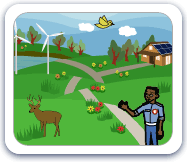
While some of the impact of computers and the Internet has unfortunately been negative, much of it has also been positive. Here's just a few of the ways that technology is helping to improve the environment:
- It helps us develop and produce new materials and technologies that are sustainable and do not harm the environment, so we can eventually stop using ones that do harm it
- It allow us to monitor and study our environment to better understand how it works and the impact of our actions on it
- It helps us create smarter technologies that respond to how we use them and adjust themselves to reduce their environmental impact, such as lights that can sense when no one is in the room and automatically turn off
- It allows us to have a worldwide virtual laboratory, so that experts from all fields can share their research, experience and ideas to come up with better, smarter solutions. Not only does this allow people far away from each other to work together, but it also reduces the environmental impact people would normally cause from traveling to meet with each other
- It allows for paperless communication like email and online bill paying to reduce the amount of trees cut down
- It allows companies to reduce shipping and manufacturing impact and to reach a broader audience
Sometimes people can get so excited about using a new technology that they overlook the negative impact on the environment. But, it's very important that we use technology in the smartest and most responsible manner, so that we are solving problems, not creating more for the future.
Environmental Issues | Being Green | Reducing Waste

